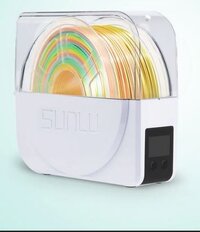- Joined
- Nov 3, 2004
- Messages
- 3,136
- Reaction score
- 1,515
- Points
- 337
- Location
- Bay Area CA
- Printer Model
- CR-10, i560 ,MFC-7440N
It's been a while since we've had this discussion. And I don't think we've had any long threads about this.
What are y'all using as filament dryers, storage, desiccant, etc. these days?
For me:
What are y'all using as filament dryers, storage, desiccant, etc. these days?
For me:
- Dryer: Rarely need one, but when I do, a food dehydrator.
- Storage:
- Vac-bags with ziploc type seal on the top and either a hand pump or electric pump to vacate the air. I also put desiccant in with the filament.
- Air-tight plastic storage boxes with a ton of desiccant
- Desiccant: I use the blue-to-pink silica gel beads, and I put them in the microwave on low to recharge them. Gotta be careful not to get them too hot.


